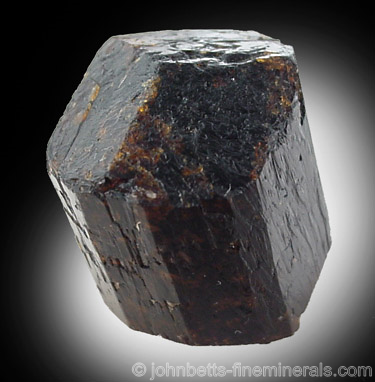The Mineral dravite

Dravite is best known as the "Brown Tourmaline". It is a relatively common form of Tourmaline, and often forms in crude uninteresting formation. However, crystals from certain localities can be highly lustrous and beautifully crystallized. Dravite is named after Dravograd, in Slovenia, the area where Dravite was first described.
Dravite may be partially replaced or intergrown together with Schorl, with a specimen being part Dravite and part Schorl. Dravite is also very similar to Uvite and Fluor-uvite, and may occur together with Uvite/Fluor-uvite in a single crystal. It can sometimes be very difficult to make an exact distinction between Dravite and Uvite/Fluor-uvite.
Chemical Formula
NaMg3Al6(BO3)3Si6O18(OH)3F
Color
Brown, dark orange-brown, dark yellow, brownish-black. Rarely green, yellow, and orange.
Crystal Habits
Most often as prismatic crystals. Crystals can be short and stubby or elongated, and are usually well-terminated with a pointed triangular cross-section. Crystals may have multiple growth layers, and are commonly doubly terminated. They may also be found as floater crystals. The most common aggregate form of Dravite is columnar. Also occurs radiating, fibrous, in dense groups of tiny, elongated
needles, and in compact masses.
Varieties
-
Rare member of the Tourmaline group that is the chromium analogue of Dravite. It is sometimes considered a variety of Dravite, but it is recognized as an individual mineral species by the IMA. Its chemical formula is NaMg3(Cr,Fe3+)6(BO3)3Si6O18(OH)4.
-
Form of Dravite where part of the hydroxyl is replaced with
fluorine. Fluor-dravite was recognized as a distinct mineral
species by the IMA in 2010, with the following chemical formula:
NaMg3Al6(BO3)3Si6O18(OH)3F
-
Rare member of the Tourmaline group that is the vanadium analogue of Dravite. It is sometimes considered a variety of Dravite, but it is scientifically recognized as an individual mineral species. Its chemical formula is NaMg3V6(BO3)3Si6O18(OH)4.
Uses
Dravite is mainly a collectors minerals. Though much Dravite is mostly in dull forms that are uninteresting to collectors, the large well formed crystals and rare transparent forms are very much in demand among collectors and can obtain premium prices. Dravite is rarely used in jewelry.
See the gemstone section on Tourmaline for more detailed information.
Noteworthy Localities
Some of the largest Dravite crystals come from the well-known locality of Yinnietharra Station, Western Australia. Another important Australian locality is May Downs Station, near Mt. Isa, Queensland.
The type locality of Dravite, where it was first described, is Dobrova, Dravograd, Slovenia. This locality has produced fine collectors specimens. Other European occurrences are Crevoladossola, Val d'Ossola, Italy; and the Lengenbach Quarry, Binn Tal, Wallis, Switzerland.
Excellent Dravite crystals have come from Jajarkot District, Bheri, Nepal; Luc Yen, Yenbai Province, Vietnam; and the Malkhan Pegmatite, Transbaikalia, Siberia, Russia. Fine Dravite crystals, which may be confused with Uvite, comes from Serra das Éguas, Brumado, Bahia, Brazil. An extremely rare and prized bright gemmy green form of Dravite comes from the Merelani Hills, Arusha, Tanzania.
In the U.S., some of the best crystals are from Bethel, Fairfield Co., Connecticut; and from the Dunton Quarry, Newry, Oxford Co., Maine. Outstanding orange-brown Dravite crystals come from St Lawrence Co., New York, at the Reese Farm in Gouverneur; and nearby at Richville. Several good crystals also came from the Inwood Hill marble, on the north end of Manhattan Island, in New York City.
Common Mineral Associations
Calcite, Muscovite, Biotite, Phlogopite, Quartz, Chlorite, Tremolite, Talc, Orthoclase, Sillimanite, Kyanite
Distingushing Similar Minerals
Schorl - Lacks brownish hue.
Uvite - When occurring in deposits where both Dravite and Uvite occur simultaneously, cannot be determined without chemical analysis.
Almandine - Different crystal form, although may look similar on termination end.